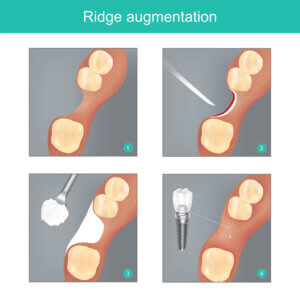More and more people choose to replace their missing or damaged teeth with dental implants. However, in order to be a candidate for a successful dental implant procedure, you need to have a healthy jawbone. For those without the necessary jawbone thickness, there are a number of procedures that can help them. For example, to prepare for your dental implants and encourage them to fuse with your jawbone, Dr. Kissel may recommend a dental bone graft or ridge augmentation to prevent bone resorption and create the best possible anchor for your new teeth.
Let’s take a closer look at what dental bone grafts and ridge augmentations are, and examine some of the benefits of these procedures.
What is a Dental Bone Graft?
Because of your missing teeth, you may lose too much bone tissue and won’t be able to have dental implant surgery. This is because tooth roots not only hold our teeth in place but also stimulate the growth of jaw bone tissue. Consequently, if you’ve lost teeth that haven’t been replaced immediately, it’s possible that you will experience jaw bone tissue loss. Therefore before having dental implant surgery you will need to undergo bone-rebuilding surgery. This additional, pre-implant procedure will allow periodontist Dr. Kissel to rebuild your lost jaw bone tissue.
How is Bone Grafting Performed?
Bone grafting procedures can be unique but we can provide you with some general information.
During the bone grafting procedure, Dr. Kissel will provide anesthesia to ensure you are completely comfortable during your surgery. After that, an incision is made to access your jawbone. Then the grafting material will then be placed into your jawbone (alveolar ridge) and secured. Finally, the surgical site will be sutured up.
Types of Grafts
There are different types of materials used for bone grafts. For example:
- Alloplast: is one of the most commonly used materials. It is synthetic and generally contains calcium, hydroxylapatite, and phosphorous. This material is safe to use since research has shown that it is not carcinogenic or inflammatory.
- Autograft: the bone graft material is taken from another part and transplanted to your jaw.
- Allograft: the material is taken from a human donor.
- Xenograft: Bone graft material comes from an animal source.
Of all four types of grafts, the ideal material is an autograft, as it has the greatest chance to heal and grow faster within your jawbone. The material for your dental bone graft is discussed and decided on before your procedure.
What is Ridge Augmentation?

During this procedure, Dr. Kissel will regenerate the jawbone to enable future implant placement. In instances where the bone loss is not severe, ridge augmentation can be performed at the same time as the dental implant placement procedure.
Why get a Ridge Augmentation?
The main reason a ridge augmentation is performed is to reconstruct patients’ jawbones for both aesthetic reasons and to prepare patients for dental implant placement. This procedure can be used to help smooth and mold the newly formed bone to its original form. A ridge augmentation is normally performed after tooth extraction since it is the ideal time to form and fill in the cavity left by the tooth that had been removed.
A ridge augmentation can help shape the jaw to its original shape and reduce the possibility of the jawbone becoming misshapen or deformed. When teeth are extracted and not replaced by tooth implants soon afterward, indentations can occur in the teeth sockets. These indentations can result in an unnatural look in your gums and jaw. Therefore a ridge augmentation can help recapture the original appearance of your jaw and mouth.
The Difference Between Bone Graft and Ridge Augmentation
Both procedures have to do with reconstructing the jawbone. The main difference between them is how this is done (i.e. the process involved). Basically, a bone graft procedure is performed to help stimulate and encourage bone healing after. However, ridge augmentation is performed to form and shape the jawbone to achieve the desired form and regain any lost function.
Find Out What’s Right For You
Nowadays, it’s not difficult to find information about any dental or periodontal procedures online but the only way to find out what procedure is right for you is to book a consultation with a skilled periodontist and dental implant specialist like Dr. Kissel in Manhattan, NYC. He has over twenty years of experience performing these techniques on a daily basis. It’s this experience that allows him to perform skillful surgery with predictable results and minimal to no complications.
Dr. Kissel uses the most advanced and proven techniques to treat your dental and periodontal issues. His microsurgical techniques allow for a better experience post-op for the patient due to greater accuracy and a more precise operation.
During your consultation, Dr. Kissel will inform you about what’s right for you and the type of dental implants you are eligible for. He can explain the dental bone grafting procedures to you, and answer all your questions. If you’re ready to replace your smile with natural-looking, functional dental implants, then call Dr. Kissel’s office in New York City for a consultation at (212) 702-9088 or book online.
